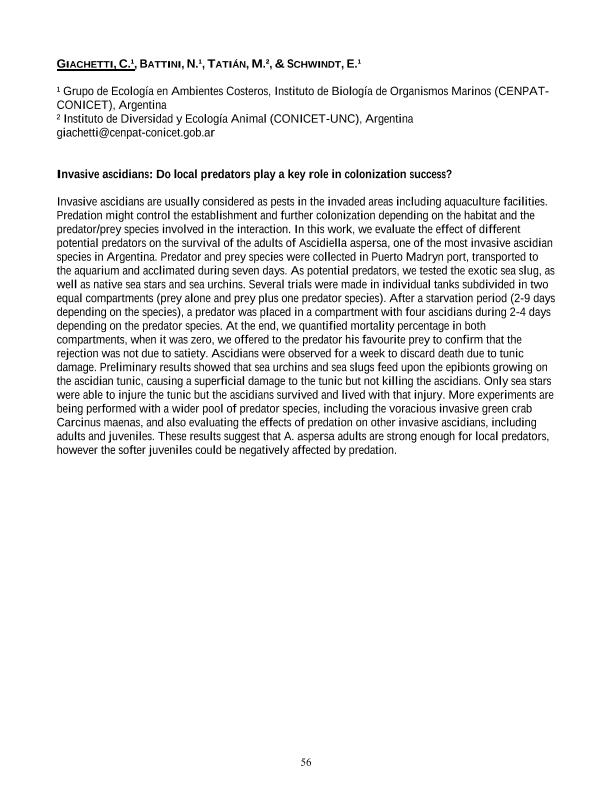Mostrar el registro sencillo del ítem
dc.contributor.author
Giachetti, Clara Belen

dc.contributor.author
Battini, Nicolás

dc.contributor.author
Tatian, Marcos

dc.contributor.author
Schwindt, Evangelina

dc.date.available
2022-04-08T13:27:36Z
dc.date.issued
2016
dc.identifier.citation
Invasive ascidians: Do local predators play a key role in colonization success?; Marine and Freshwater Invasive Species: Ecology, Impact and Management; Buenos Aires; Argentina; 2016; 56-56
dc.identifier.uri
http://hdl.handle.net/11336/154730
dc.description.abstract
Invasive ascidians are usually considered as pests in the invaded areas including aquaculture facilities. Predation might control the establishment and further colonization depending on the habitat and the predator/prey species involved in the interaction. In this work, we evaluate the effect of different potential predators on the survival of the adults of Ascidiella aspersa, one of the most invasive ascidian species in Argentina. Predator and prey species were collected in Puerto Madryn port, transported to the aquarium and acclimated during seven days. As potential predators, we tested the exotic sea slug, as well as native sea stars and sea urchins. Several trials were made in individual tanks subdivided in two equal compartments (prey alone and prey plus one predator species). After a starvation period (2-9 days depending on the species), a predator was placed in a compartment with four ascidians during 2-4 days depending on the predator species. At the end, we quantified mortality percentage in both compartments, when it was zero, we offered to the predator his favourite prey to confirm that the rejection was not due to satiety. Ascidians were observed for a week to discard death due to tunic damage. Preliminary results showed that sea urchins and sea slugs feed upon the epibionts growing on the ascidian tunic, causing a superficial damage to the tunic but not killing the ascidians. Only sea stars were able to injure the tunic but the ascidians survived and lived with that injury. More experiments are been performing with a wider pool of predator species, including the voracious invasive green crab Carcinus maenas, and also evaluating the effects of predation on other invasive ascidians, including adults and juveniles. These results suggest that A. aspersa adults are strong enough for local predators, however the softer juveniles could be negatively affected by predation.
dc.format
application/pdf
dc.language.iso
eng
dc.publisher
Aquatic Ecosystem Health and Management Society
dc.rights
info:eu-repo/semantics/openAccess
dc.rights.uri
https://creativecommons.org/licenses/by-nc-sa/2.5/ar/
dc.subject
INVASIVE ASCIDIANS
dc.subject
PREDATION
dc.subject
MARINE PORTS
dc.subject.classification
Biología Marina, Limnología

dc.subject.classification
Ciencias Biológicas

dc.subject.classification
CIENCIAS NATURALES Y EXACTAS

dc.subject.classification
Ecología

dc.subject.classification
Ciencias Biológicas

dc.subject.classification
CIENCIAS NATURALES Y EXACTAS

dc.title
Invasive ascidians: Do local predators play a key role in colonization success?
dc.type
info:eu-repo/semantics/publishedVersion
dc.type
info:eu-repo/semantics/conferenceObject
dc.type
info:ar-repo/semantics/documento de conferencia
dc.date.updated
2022-03-17T14:00:21Z
dc.journal.pagination
56-56
dc.journal.pais
Argentina

dc.journal.ciudad
Buenos Aires
dc.description.fil
Fil: Giachetti, Clara Belen. Consejo Nacional de Investigaciones Científicas y Técnicas. Centro Científico Tecnológico Conicet - Centro Nacional Patagónico. Instituto de Biología de Organismos Marinos; Argentina
dc.description.fil
Fil: Battini, Nicolás. Consejo Nacional de Investigaciones Científicas y Técnicas. Centro Científico Tecnológico Conicet - Centro Nacional Patagónico. Instituto de Biología de Organismos Marinos; Argentina
dc.description.fil
Fil: Tatian, Marcos. Consejo Nacional de Investigaciones Científicas y Técnicas. Centro Científico Tecnológico Conicet - Córdoba. Instituto de Diversidad y Ecología Animal. Universidad Nacional de Córdoba. Facultad de Ciencias Exactas Físicas y Naturales. Instituto de Diversidad y Ecología Animal; Argentina
dc.description.fil
Fil: Schwindt, Evangelina. Consejo Nacional de Investigaciones Científicas y Técnicas. Centro Científico Tecnológico Conicet - Centro Nacional Patagónico. Instituto de Biología de Organismos Marinos; Argentina
dc.relation.alternativeid
info:eu-repo/semantics/altIdentifier/url/https://conferences.aehms.org/mfis-argentina/
dc.conicet.rol
Autor

dc.conicet.rol
Autor

dc.conicet.rol
Autor

dc.conicet.rol
Autor

dc.coverage
Internacional
dc.type.subtype
Congreso
dc.description.nombreEvento
Marine and Freshwater Invasive Species: Ecology, Impact and Management
dc.date.evento
2016-05-02
dc.description.ciudadEvento
Buenos Aires
dc.description.paisEvento
Argentina

dc.type.publicacion
Book
dc.description.institucionOrganizadora
Aquatic Ecosystem Health and Management Society
dc.description.institucionOrganizadora
Consejo Nacional de Investigaciones Científicas y Técnicas
dc.source.libro
Abstract Book of Marine and Freshwater Invasive Species: Ecology, Impact and Management
dc.date.eventoHasta
2016-05-04
dc.type
Congreso
Archivos asociados
